A visit to the Comox Air Force Museum
On Day 35 of the trip (May 30th) I drove the motorhome 95 km from Englishman River Falls Provincial Park to the Comox Valley Airport. The destination was the Comox Air Force Museum, but it was so good that I spent the night in a parking lot. The next morning, I was only a few minutes away from the ferry to Powell River.
I posted on Facebook as I was about to leave Englishman River that “The ferry to Powell River is only an hour away but there’s goats on a roof, an air force museum and who knows what else on the way so I’ve allotted 23 hours for the trip 🙂 ” but ended up not going to Coombs where the goats are. Having taken another wander around the park, though, I didn’t hit Highway 19 northbound until about 11:30.
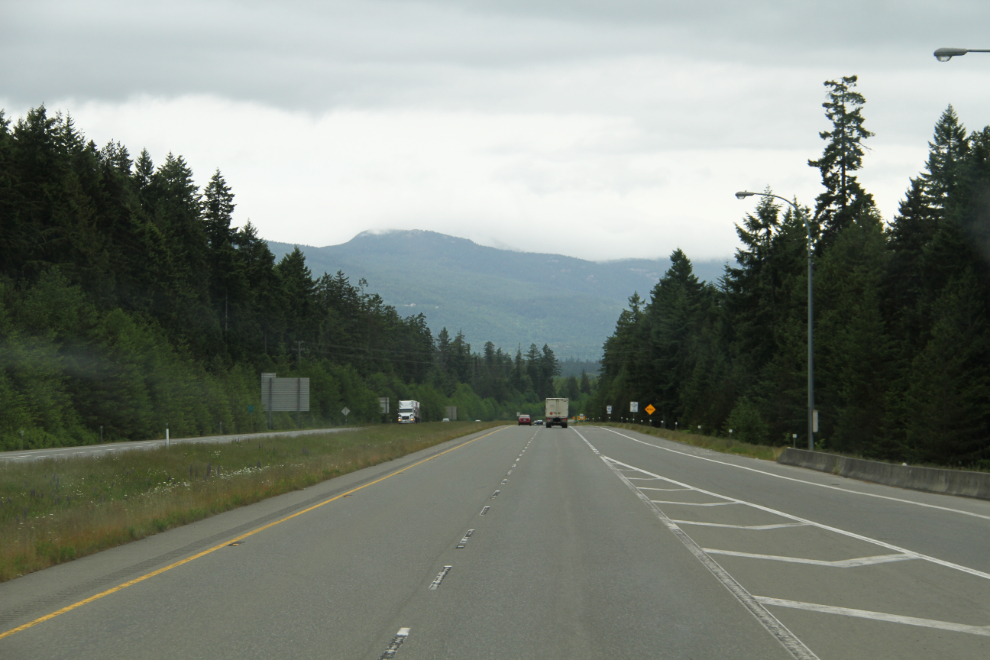
As I neared Comox, I was thinking about stopping at the visitor information centre. When I saw “a Snowbird on a stick” beside the highway, taking the next turn was an easy choice. That took me to the Comox Valley Visitor Centre.
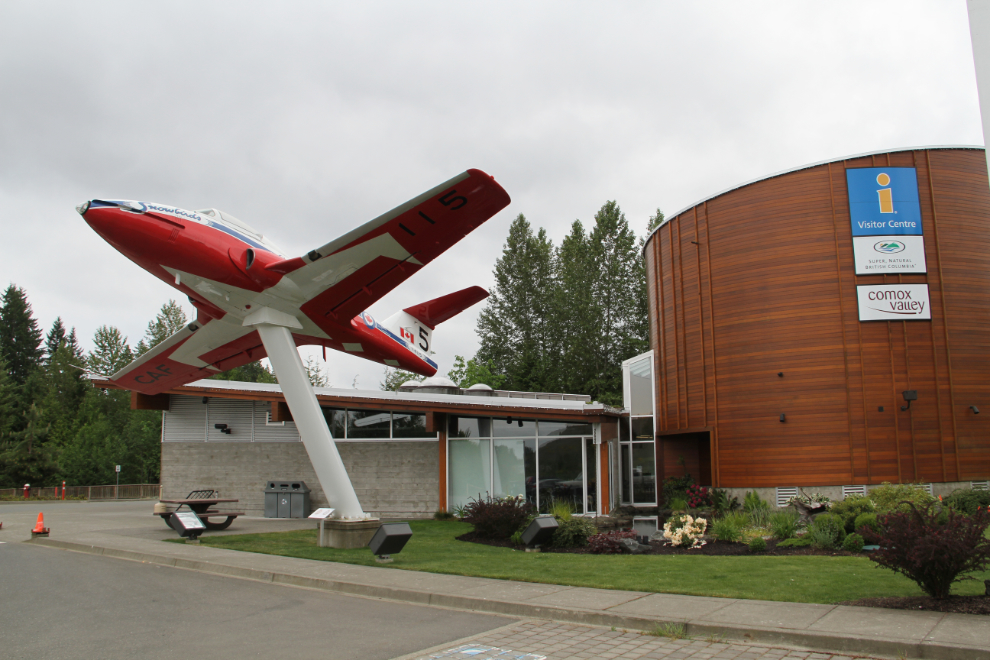
The Visitor Centre is beautiful both inside and out, and does an exceptional job of offering travellers anything they might need. Among those things is a computer area, with strong wifi, power, and computers if you need one. My battery in my laptop was almost dead, so I caught up on my blogging and social media while it re-charged.
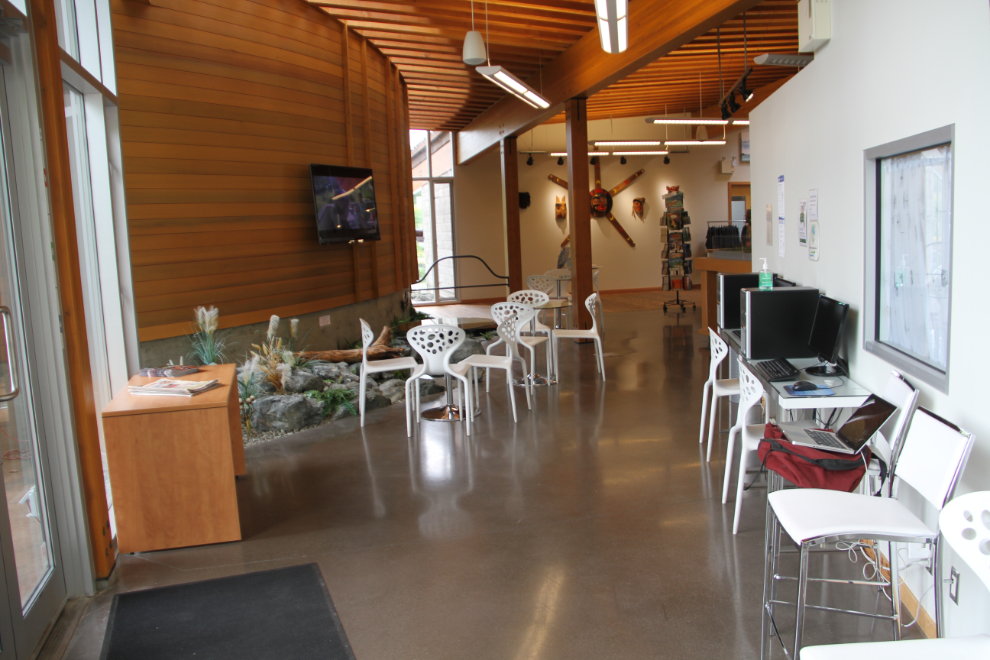
The interactive Vancouver Island Exhibit Gallery is a fun place for kids of all ages. There are several places to get your photo taken – on a mountain bike, in a sea kayak, and a few others. By the time I got back in the RV, over an hour had passed – that wasn’t my usual Visitor Centre stop!

My Garmin didn’t know where the Comox Air Force Museum was, and I ended up on some back roads. I made it, though, but the parking lot at the museum is very small so I continued on, and found a fairly large pull-off near the Comox Valley Airport terminal.
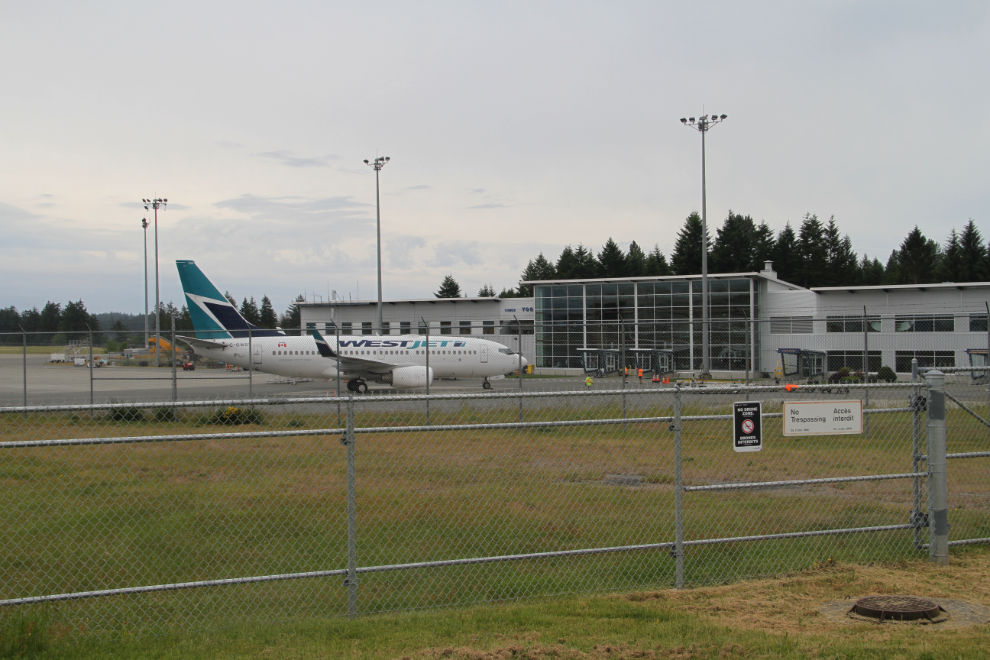
I didn’t get back to the museum until 2:30. They close at 4:00 pm, but I figured that an hour and a half would be about right – it’s just a small facility. Was I ever wrong!
The museum is located right beside the main entrance to Canadian Foces Base Comox, home of 19 Wing Comox. The entrance is guarded by this McDonnell CF-101B Voodoo, #101057. In 1984, each Voodoo squadron painted one of their aircraft to celebrate the 60th anniversary of the RCAF, and 409 Squadron used a modified version of the “Hawk One Canada” design that they have used for several years.
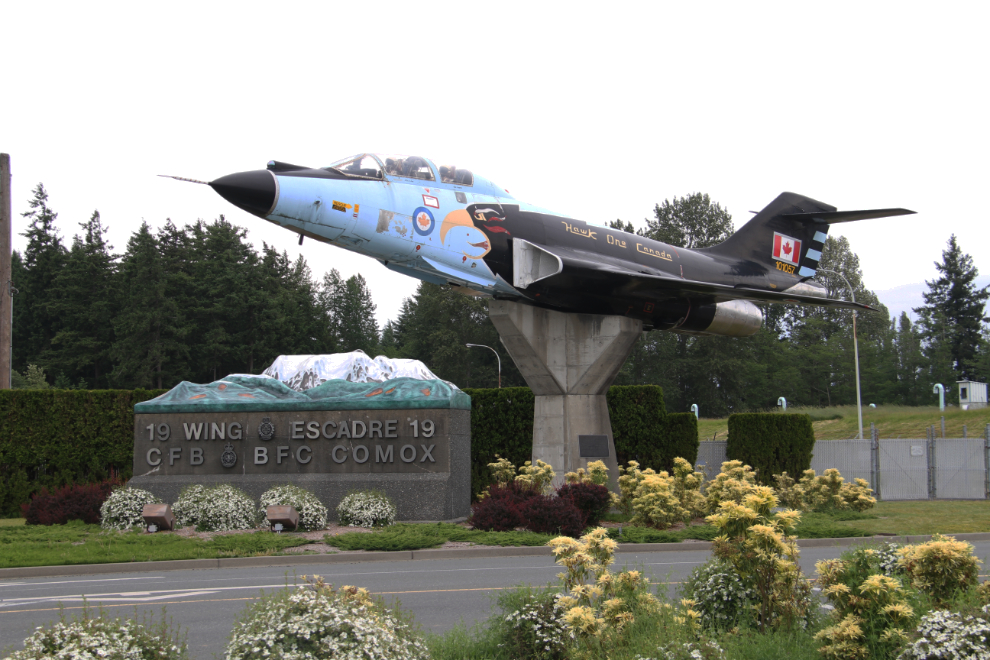
Here’s an overall view of the museum building.
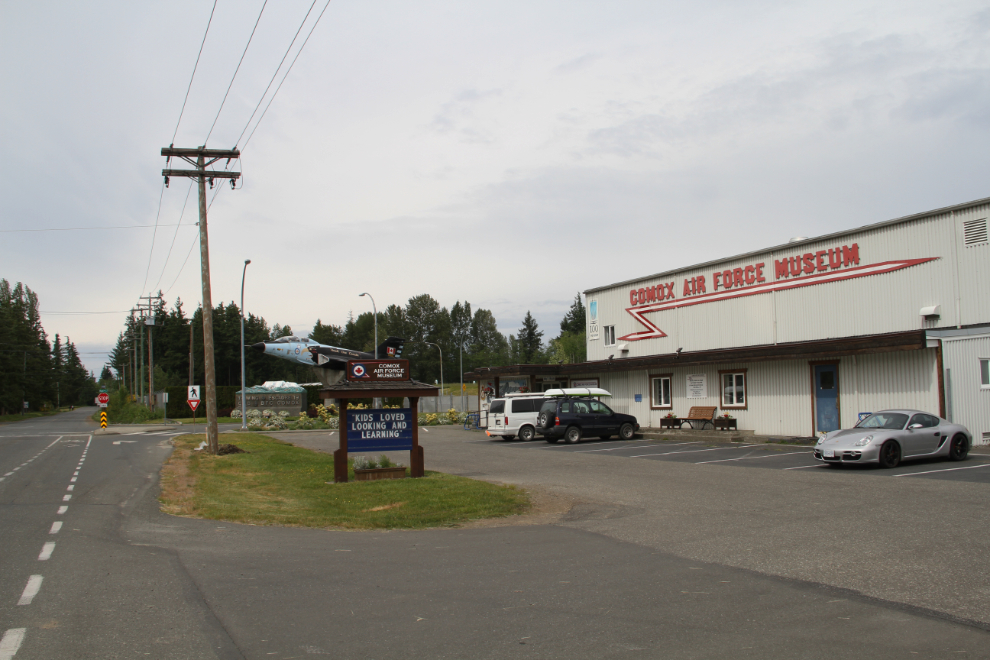
I began my tour in a side hall, which is used for rotating displays. Currently, most of it has a display of uniforms. This is Royal Canadian Air Force No. 5A Battle Dress, used from 1940 until 1968 when the RCAF ceased to exist, becoming part of the unified Canadian Forces. This is the uniform that my Dad would have worn. Being able to personalize this museum in such a way makes a big difference, I think.
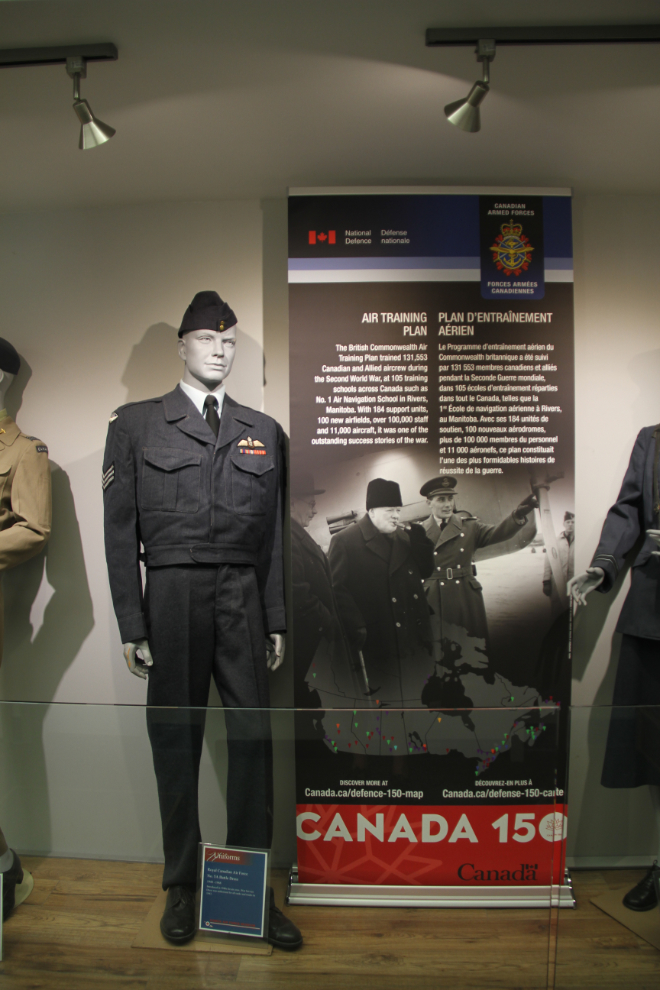
This case of aircraft models could be fun: “Think you are good at aircraft recognition? Do you really know RCAF aircraft? PROVE IT! Ask for the AC Recognition Challenge clipboard at the front counter.” While I’m curious about how I’d do, there wasn’t enough time.
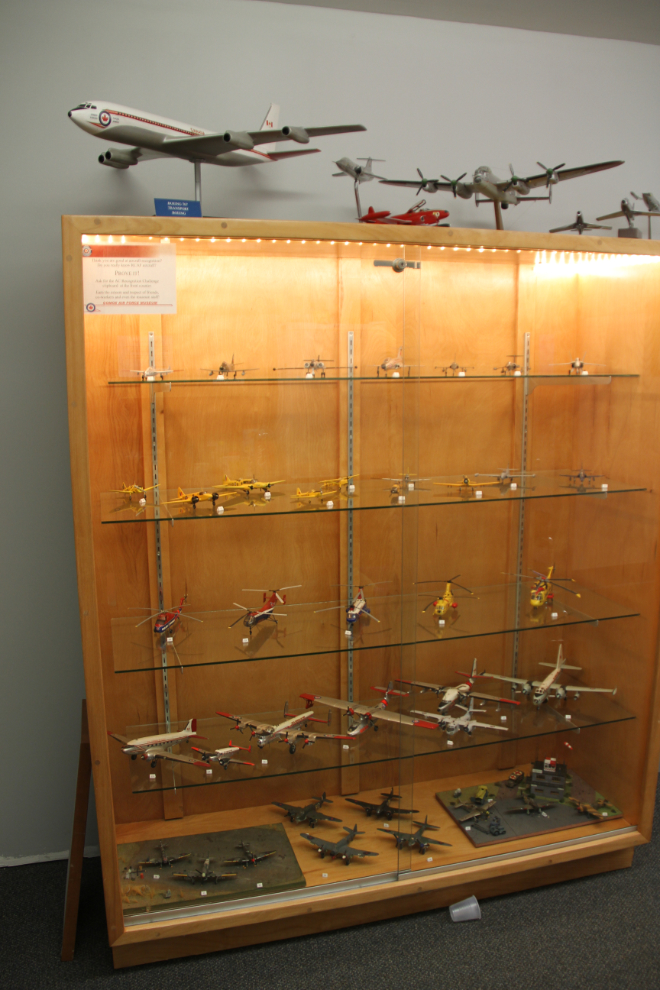
Now on to the main part of the museum. It was immediately apparent that I hadn’t allowed nearly enough time. “Welcome to the Comox Air Force Museum. Our museum presents the history of 19 Wing and CFB/RCAF Station Comox and the Squadrons stationed here, now and in the past.”

I realized very quickly that I wasn’t going to have as much time as I needed here, so the plan was to make a quick sweep around and look for the highlights – or to be more accurate, the content that resonated with me the most. Having visited the former RCAF Station Coal Harbour a few days before, this was the first panel that I spent some time with, to see how Coal Harbour fit in the system.
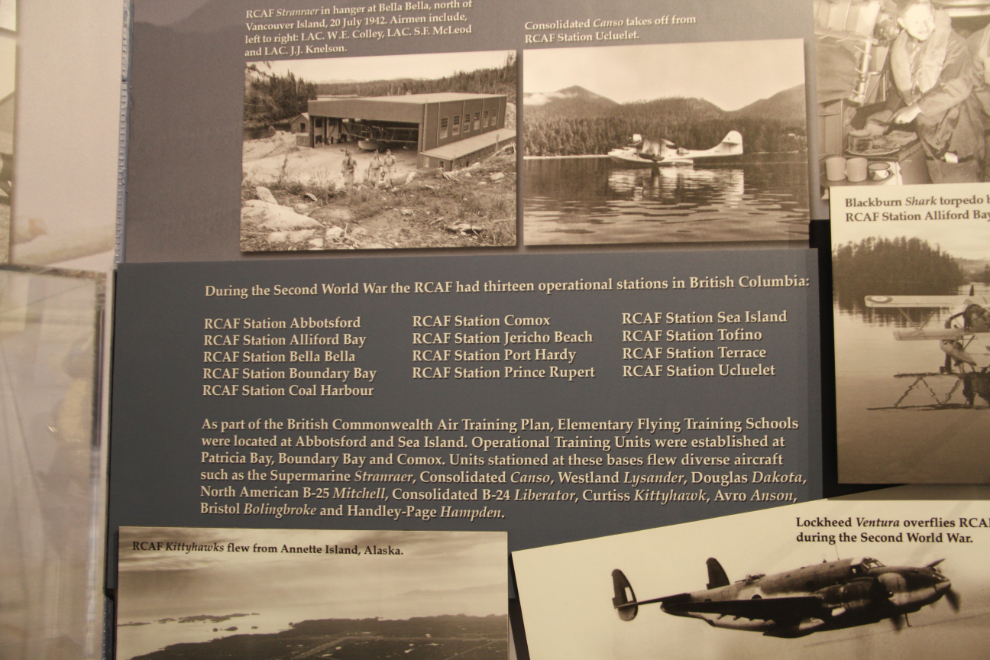
This case shows a model of the Stranraer flying boat, a type that was in service at Coal Harbour.
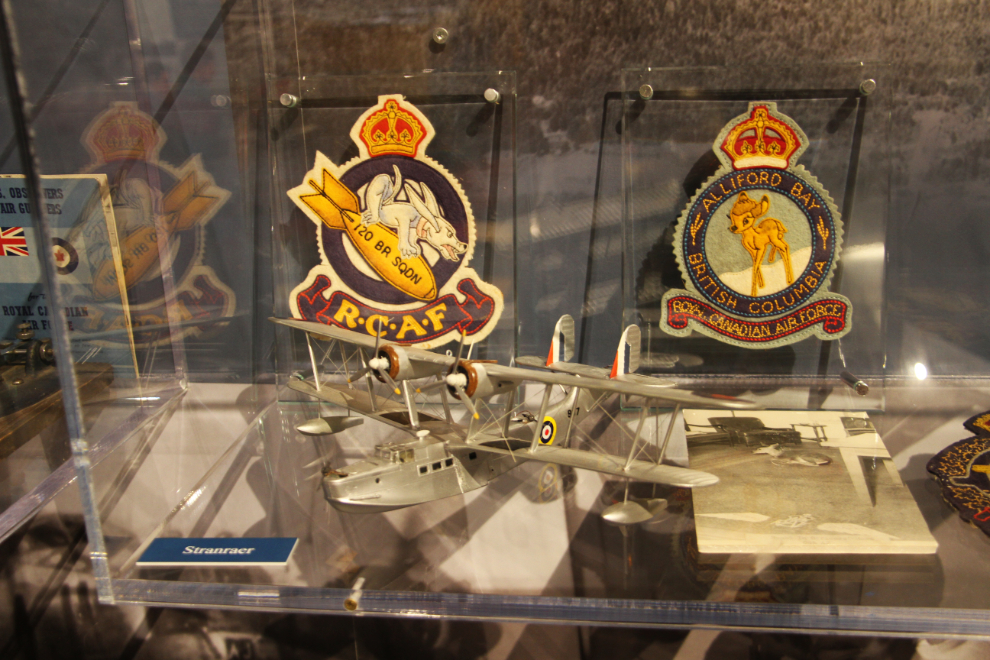
There is a section devoted to “West Coast Aviators” – local heroes. The five men profiled have impressive records. The medals, model aircraft, diary excerpts and other material in the cases adds a lot to each story
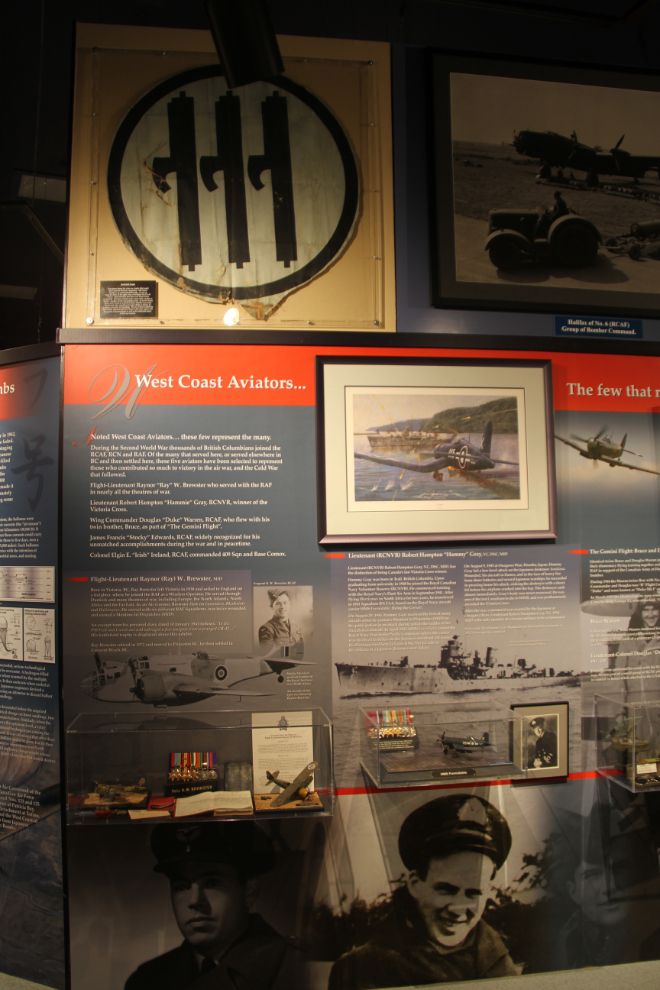
Above the first West Coast Aviators panel is a “battlefield trophy” – a Fascist Italian roundel that was cut from the wing fabric of Fiat CR-42 “Falco” which was shot down over North Africa.
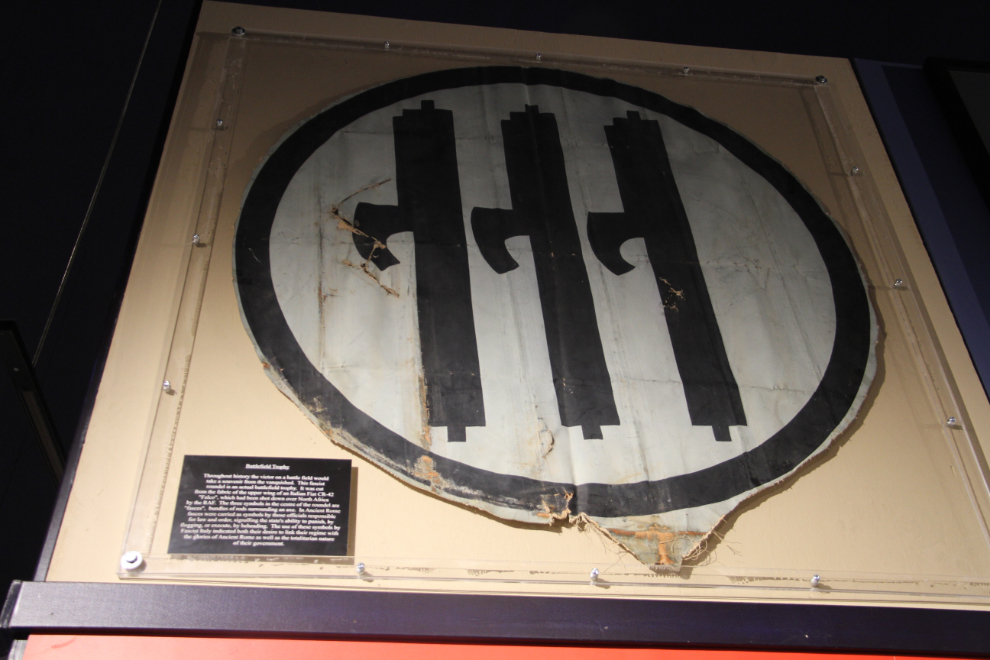
As I was reading the local hero stories, the museum’s Deputy Director, W/O Michael Barnucz, came over and introduced himself, and we spent a while discussing this museum and museums in general, from funding to displays. What we see in the museum now is the result of $250,000 spent on display panels in recent years. After 36 years in the air force, he’s about to retire, but the museum seems to be in his blood. As I’ve said before, it’s always a pleasure talking to people who are passionate about what they do.
This amazing photo shows a de Havilland Mosquito from 409 Squadron flying under the Eiffel Tower in 1945!
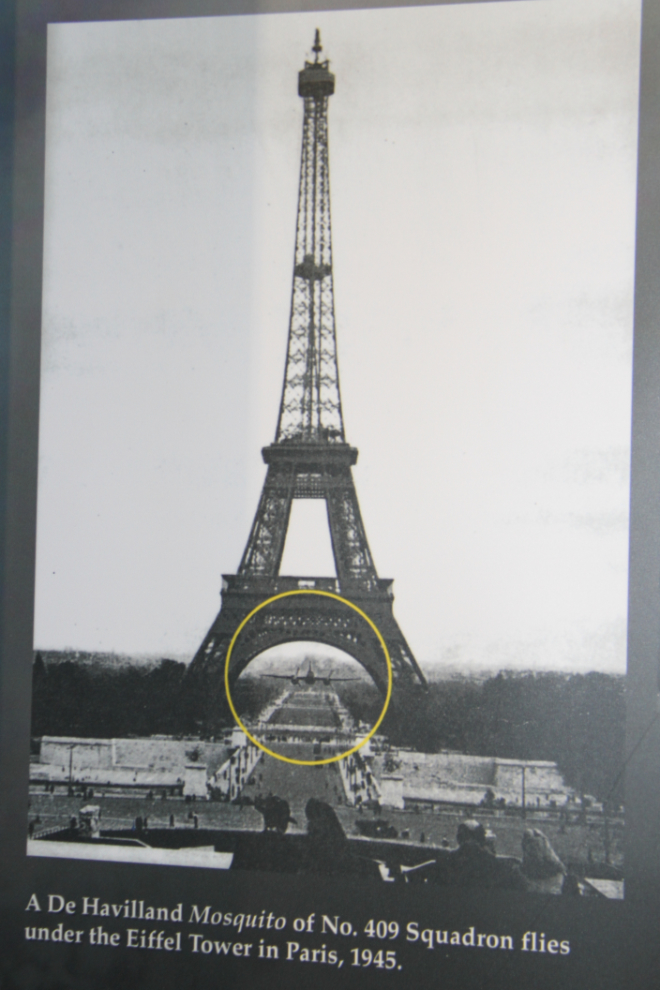
This is one of the panel which describe some of Canada’s peacekeeping roles. I hadn’t known that August 9 is National Peacekeepers’ Day.
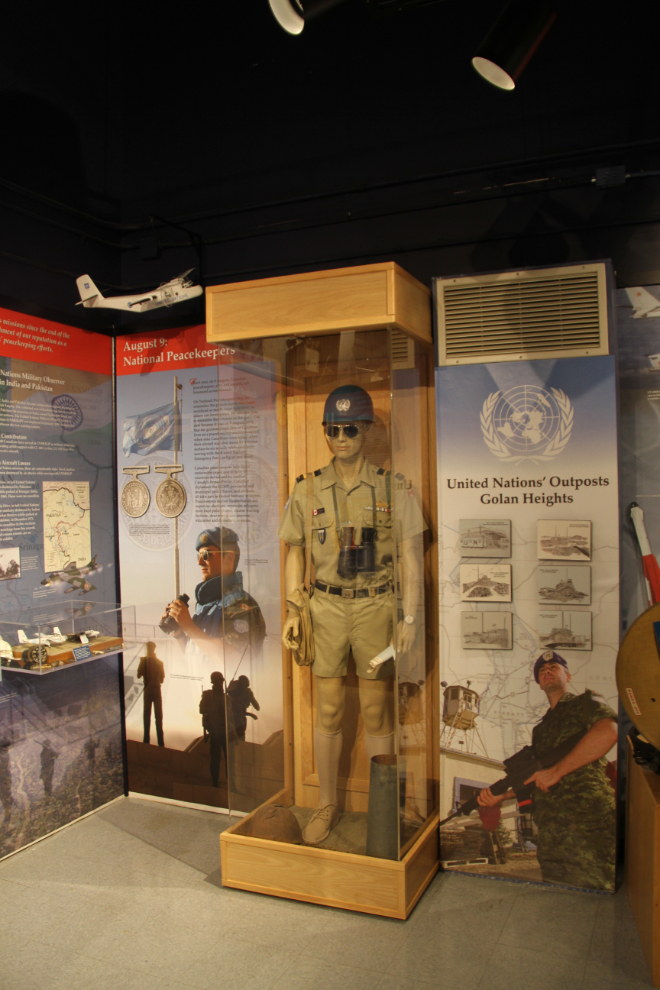
Canada lost 2 aircraft while serving with UNMOGIP – the United Nations Military Observer Group in India and Pakistan. A CC-108 Caribou in full UN markings was destroyed while parked in India in September 1965, and a CC-138 Twin Otter, also in full UN markings, was destroyed while parked in Pakisan in December 1971. There were no casualties is either attack. The display case at the bottom includes pieces of the wreckage and expended cannon rounds from the Twin Otter event. By now, it had occurred to me that this museum, in book terms, isn’t a biography of CFB Comox, it’s an autobiography. The depth of the collection and the stories told is quite remarkable.
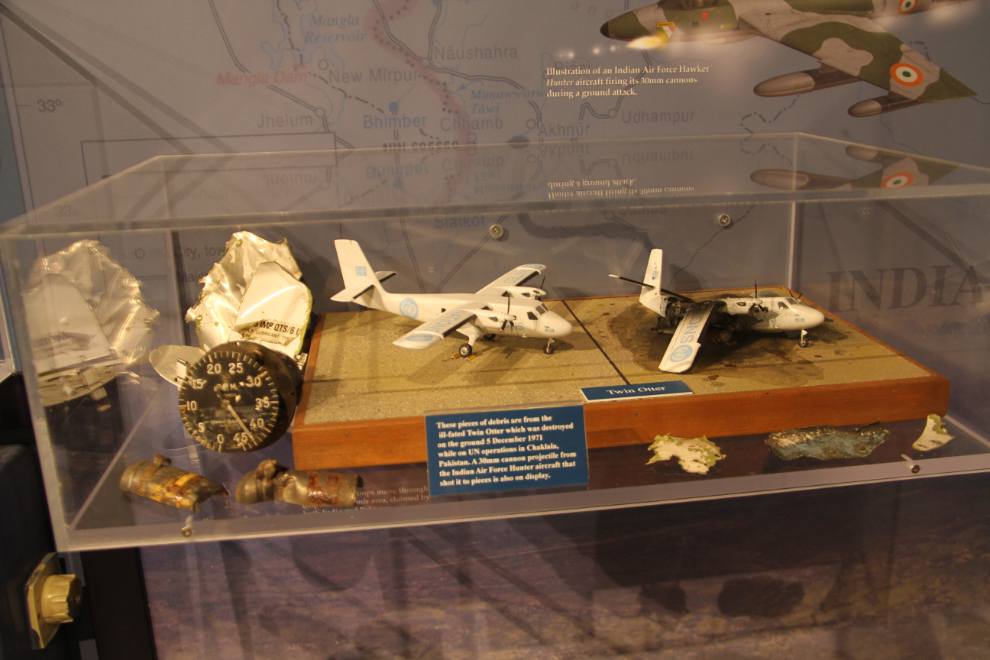
For many people, Canada’s air demonstration teams are their only emotional connection with our air force, and they are well described here. The first demonstration flying team was formed by Lieutenant-Colonel William “Billy” Barker, VC, using 4 captured German Fokker D VII scout planes! Since 1971, the Snowbirds have been the air force’s ambassadors.
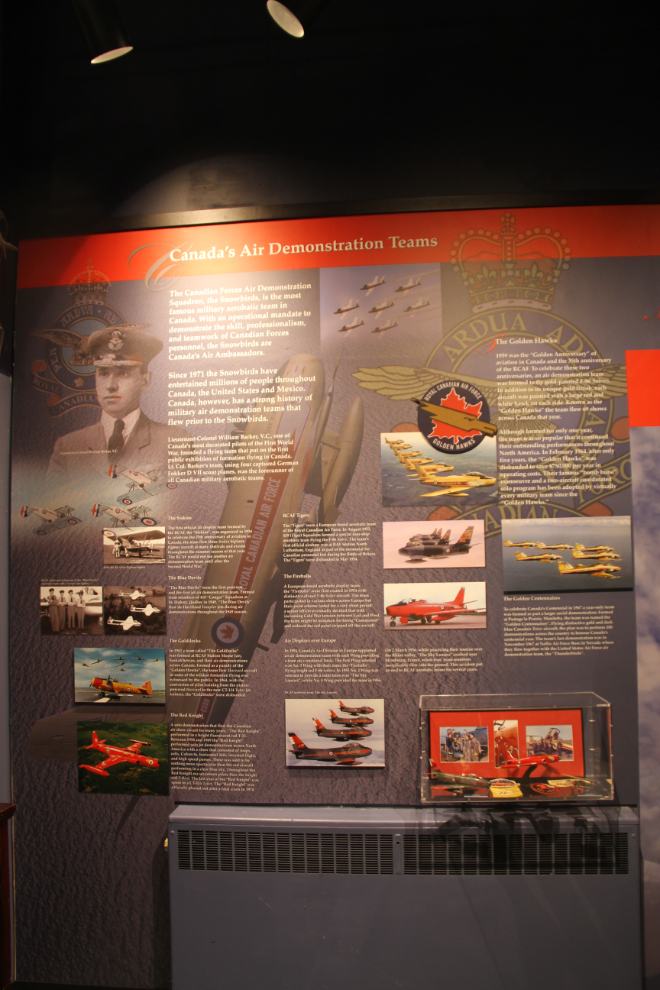
This diorama, depicting RCAF Station Comox in the late 1950s, was donated by the family of Flight Lieutenant Joseph Noel McPhee, who was killed in March 1945 when the Lancaster bomber he was flying on a night mission was shot down over Germany. He was 23 years old.
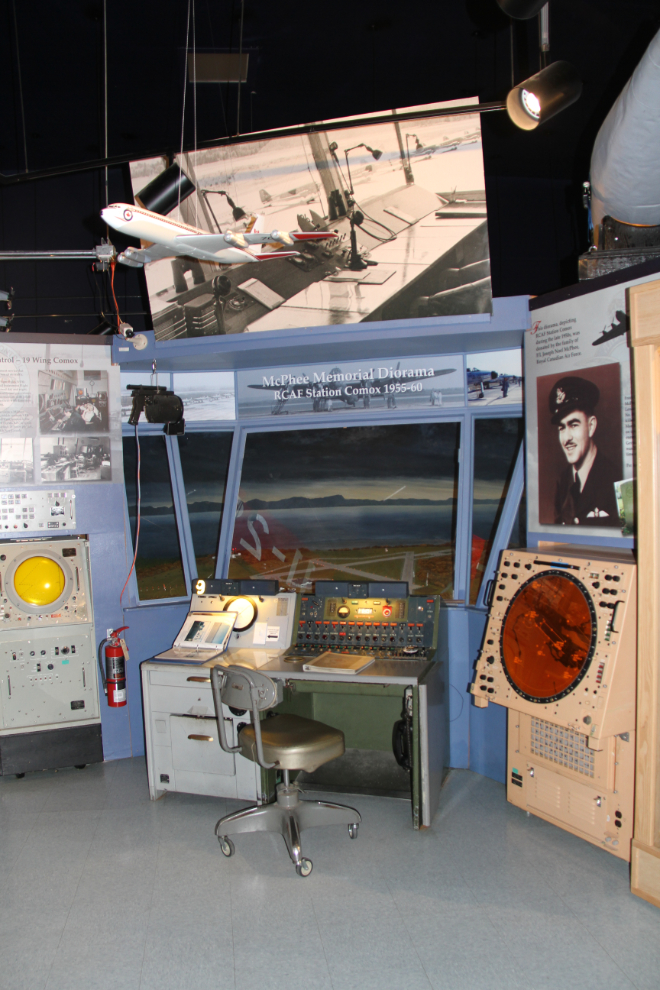
As I walked around engrossed in the displays, this mechanic surprised me a couple of times – I thought he was real 🙂
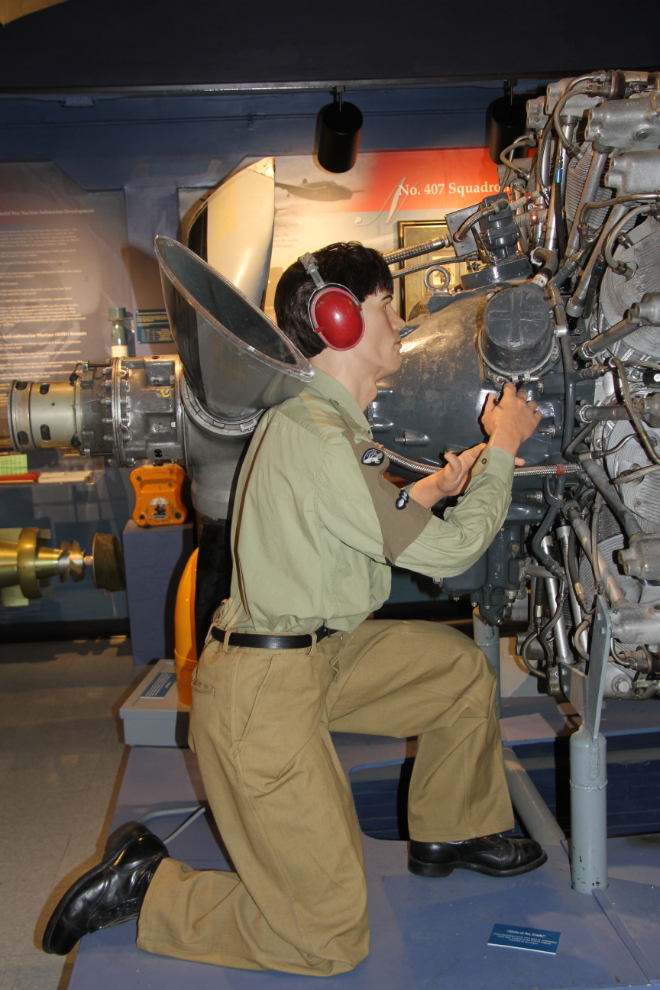
At one point while I was high-grading information, I had gone to the front desk to ask if there was any information At one point while I was high-grading information, I had gone to the front desk to ask if there was any information about Dakota 576, the DC-3 crash that my niece and I had hiked in to. I was told that they didn’t, but a few minutes later, he came out with a file folder that had much more information that what’s posted online so far. This newspaper article was one of the items in that folder.

There is some wonderful art to complement some of the stories.
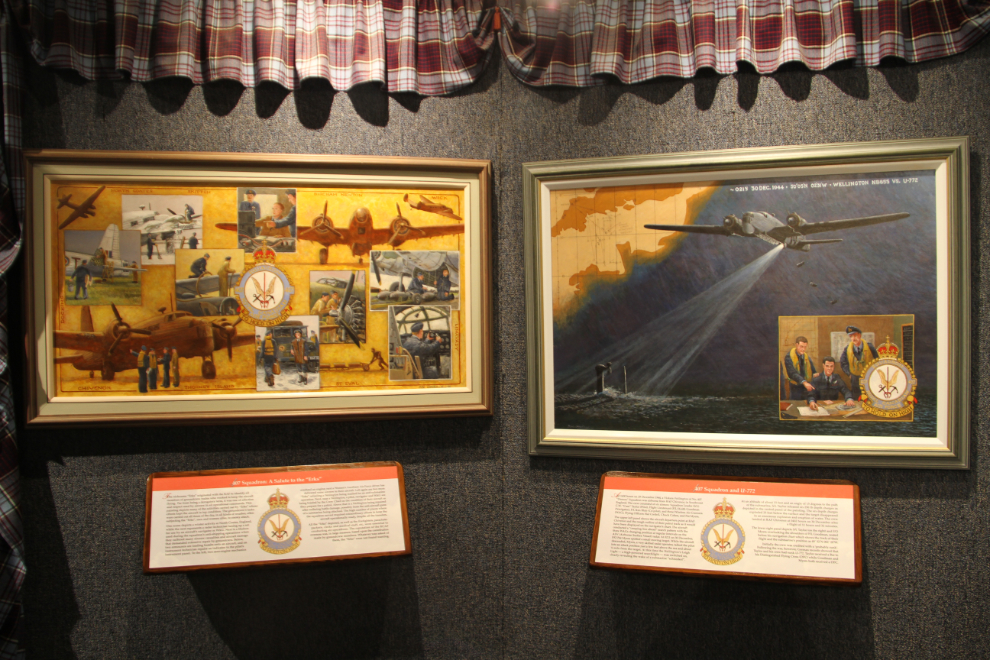
I’ve had a special connection with 442 Search and Rescue Squadron since my days working with CASARA, the civilian volunteer side of that mission, in southwestern BC. I have a lot of stories stored away from those days – some funny, some tragic…
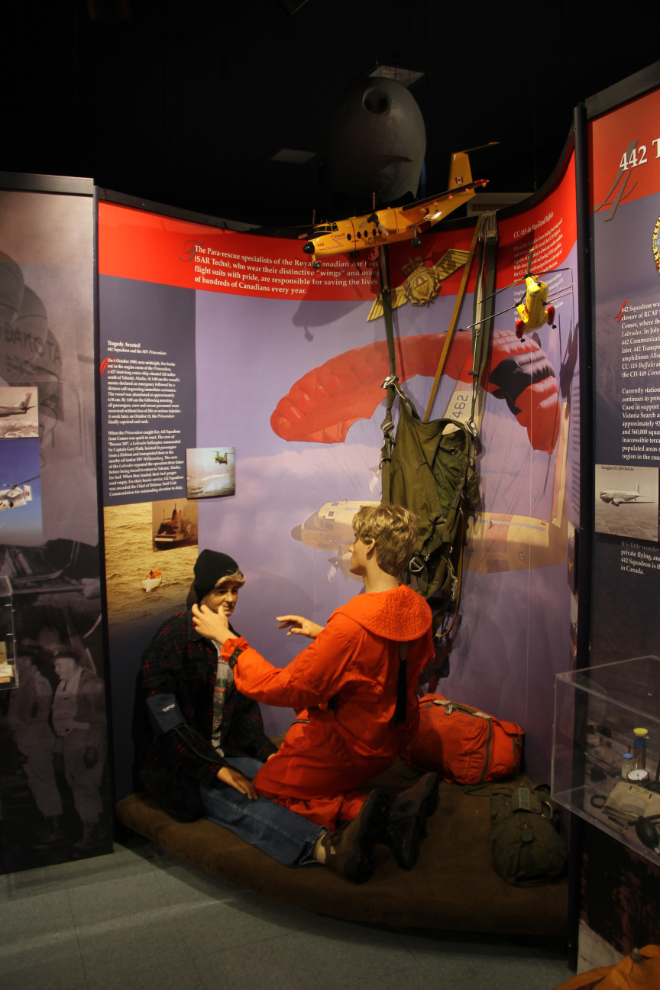
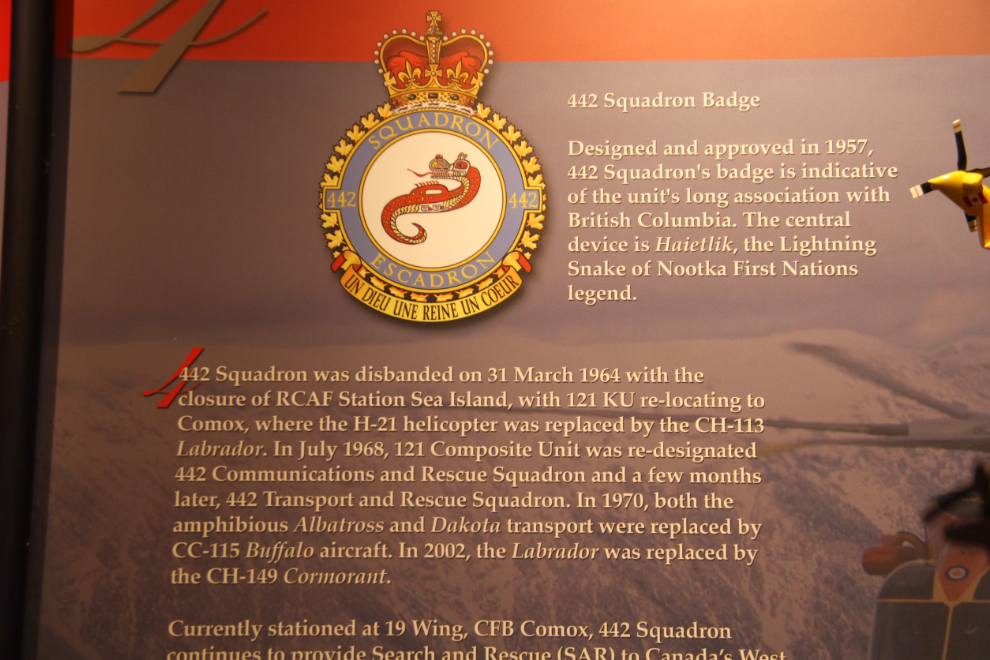
I could have spent 20 minutes just at these panels telling the story of 443 Fighter Squadron’s part in World War II.
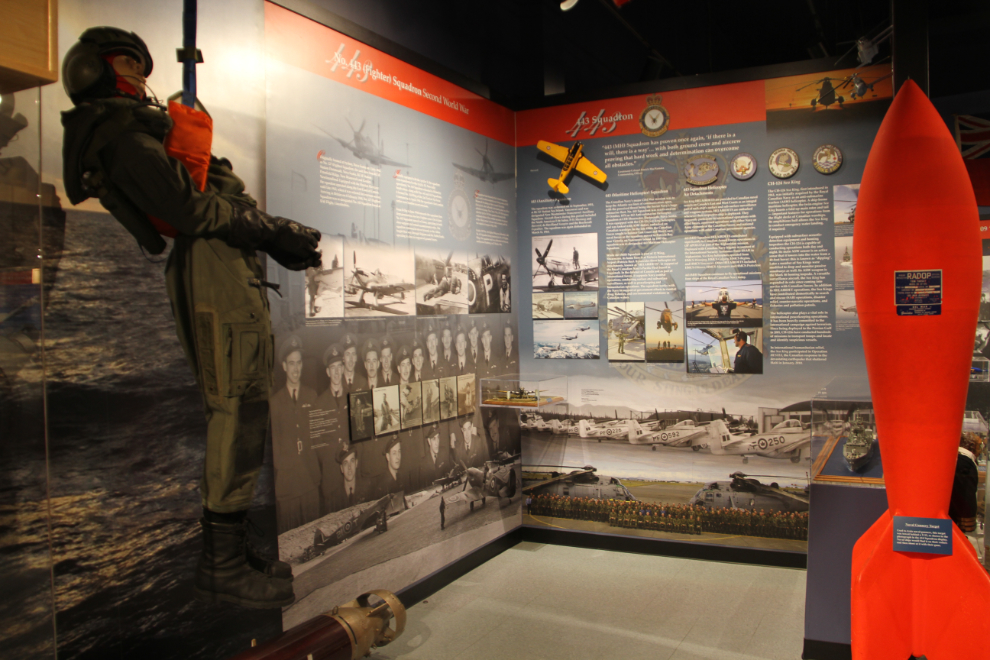
I hadn’t known that the RCAF had a Marine Section. It was formed in 1935, and during World War II peaked at 941 officers and airmen operating 384 boats “of all types and shapes.” This case holds a model of a High-Speed Rescue Launch, a crest from Marine Section Pat Bay, and a “dog-tag”.
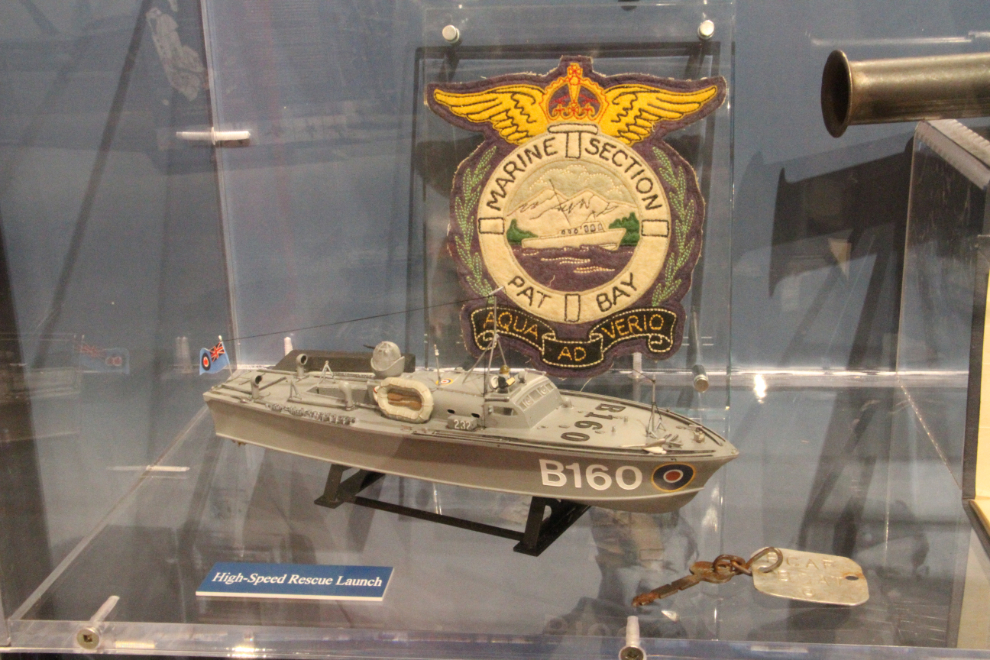
These panels describe the Avro Canada CF-105 Arrow, which was first flown on March 25, 1958. Despite incredible performance (recorded at 1,217 mph at 50,000 feet altitude), the project was cancelled 11 months later. Aviation enthusiasts often blame Prime Minister Diefenbaker for the scrapping, but this panel says that “records now available indicate the Arrow was becoming unaffordable. The Canadian Chiefs of Staff unanimously recommended the termination of the CF-105 program.” It doesn’t explain while all of the aircraft were sent to the scrap pile instead of saving them for museums.
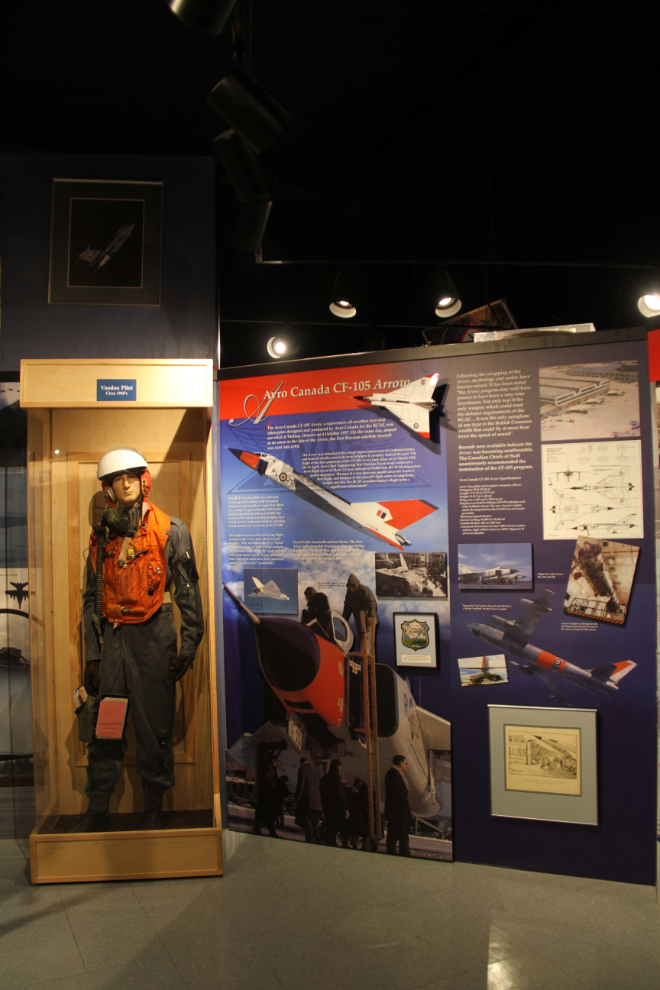
One of the interesting pieces in the Arrow collection is this crest, designed for the first Aircraft Control and Warning Systems Technicians in anticipation of the aircraft entering service. It was never worn.
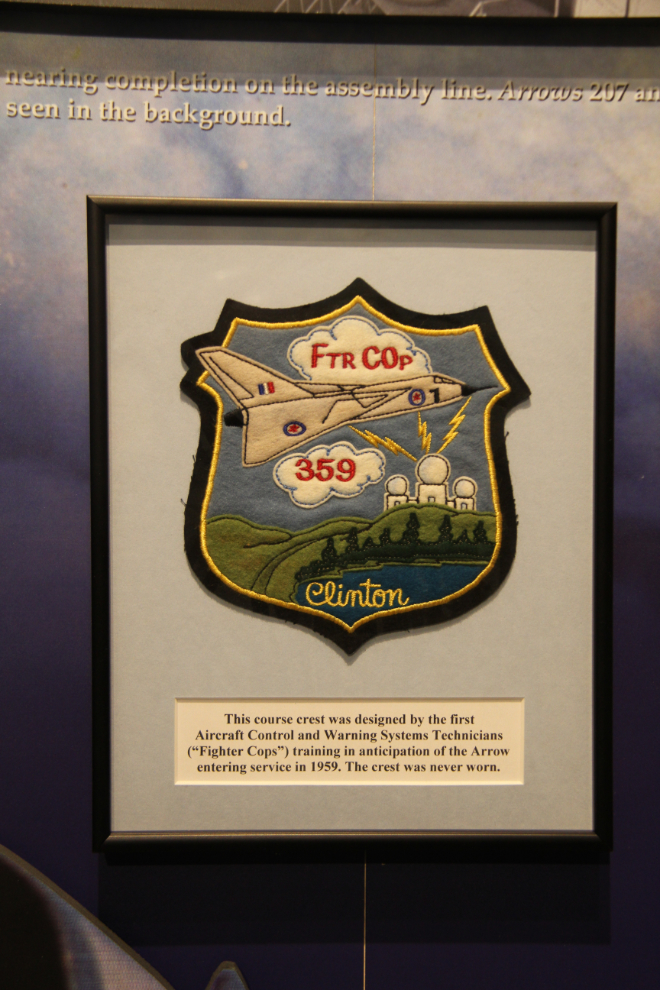
Some of the funniest pieces in the collection are these shoulder patches worn by pilots, navigators, technicians, and maintenance supervisors in CF-101B Voodoo squadrons.
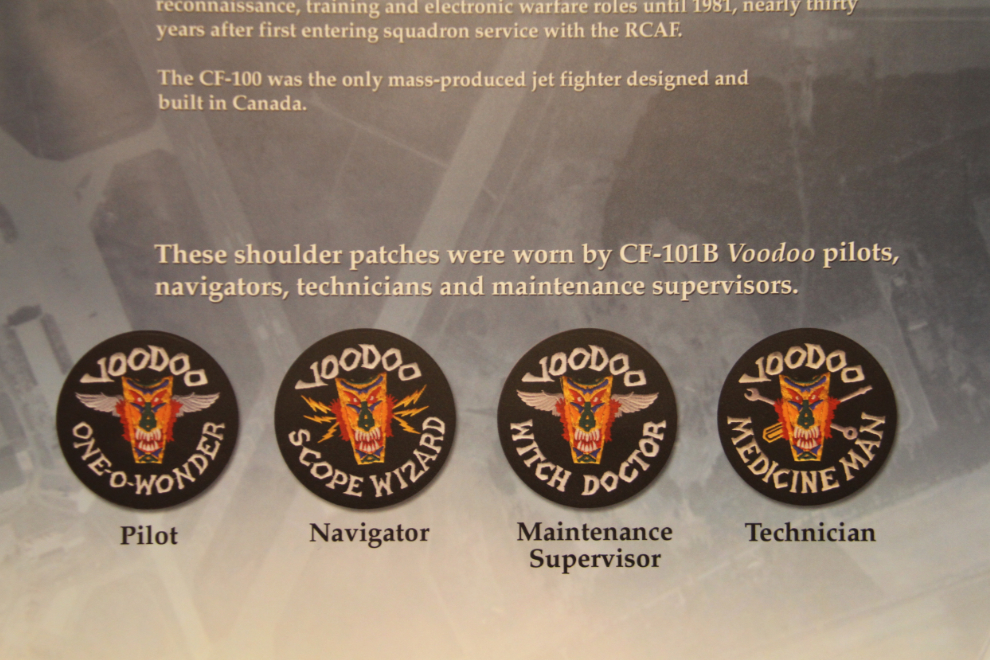
Some of the large Squadron crests on display have been beautifully crafted.
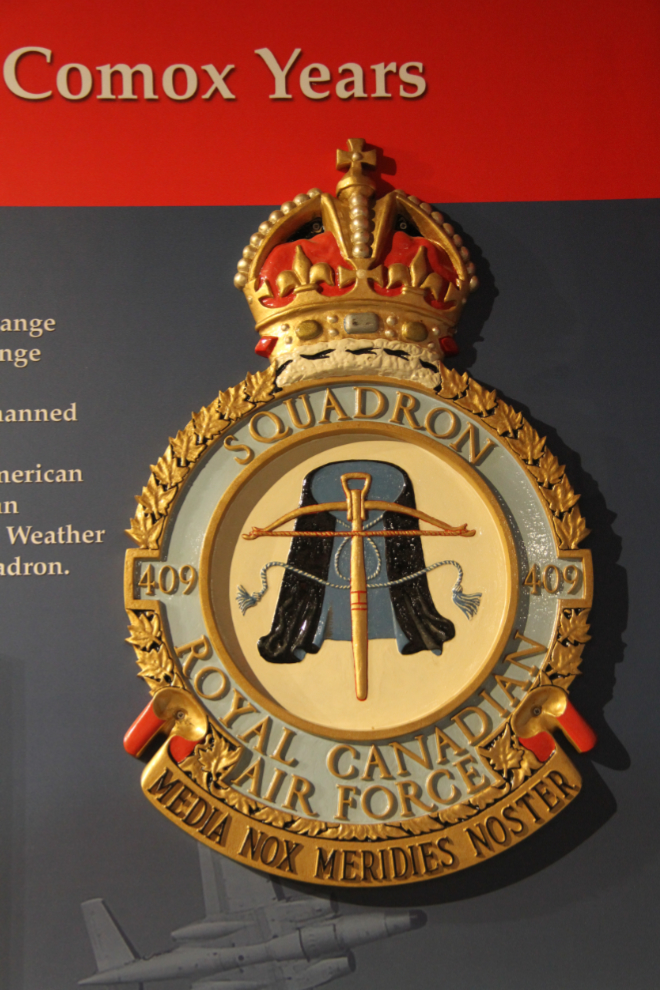
For a kid who grew up with the dangers of the Cold War hanging over his head, the panels describing what happened, and some of the tools used, were very interesting.

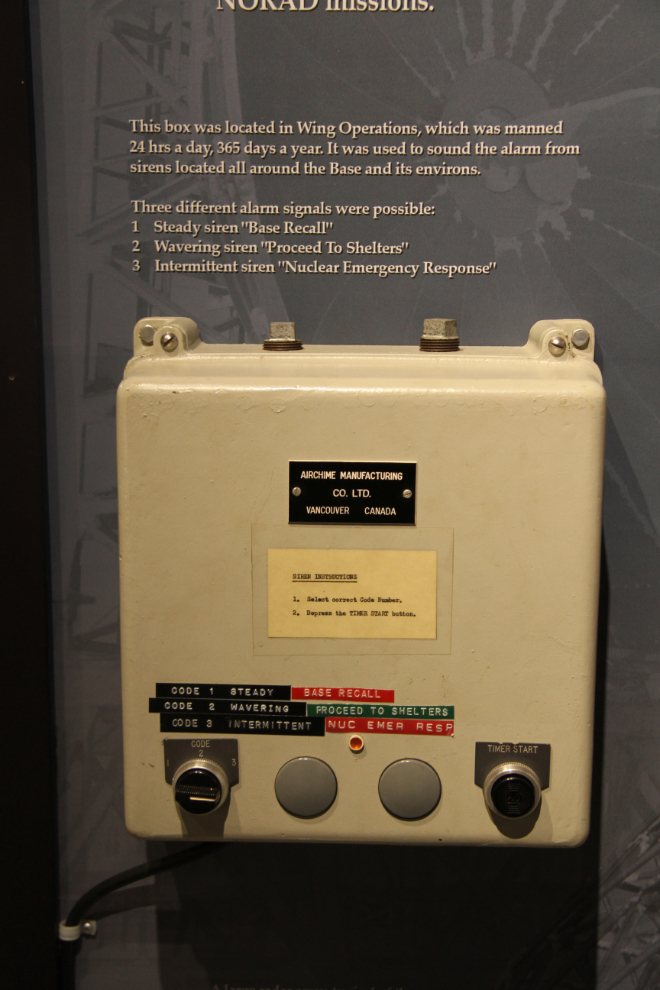
Even the nuclear protestors of the 1950s and ’60s are seen here.
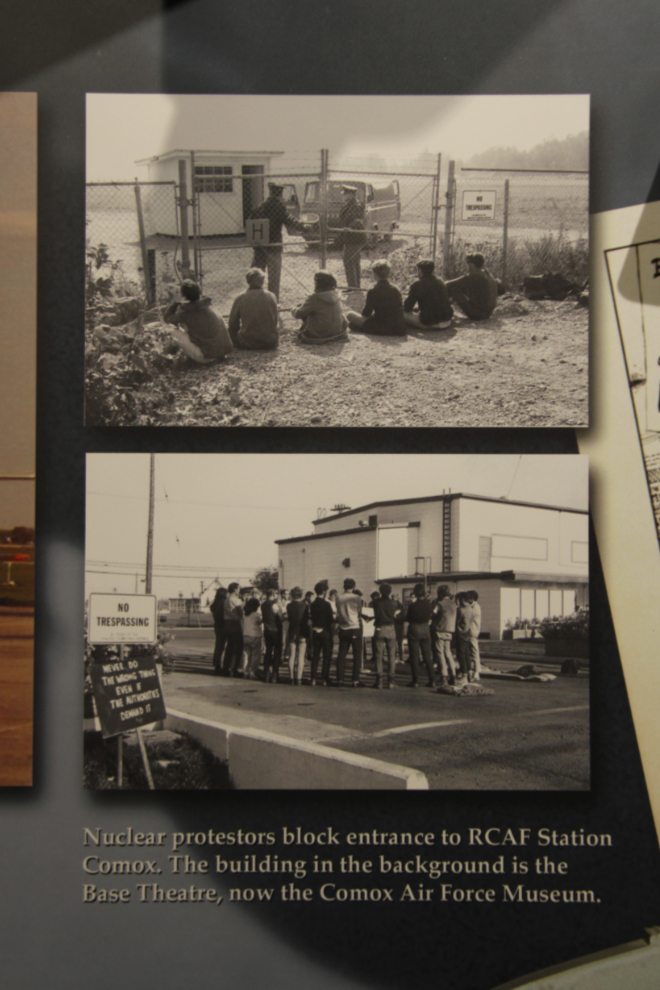
Although W/O Barnucz said that I could stay past the museum’s 4:00 pm closing, I didn’t want to keep him, so left and went over to their Heritage Air Park. I hadn’t realized that it was actually part of the museum, with the same operating hours, so I made a quick pass through. This is McDonnell CF-101B Voodoo #101030. The Voodoos were in service from 1961 until 1990, when they were replaced by McDonnell Douglas CF-18 Hornets.

A look at the far end of the air park, with an Aurora and DC-3.
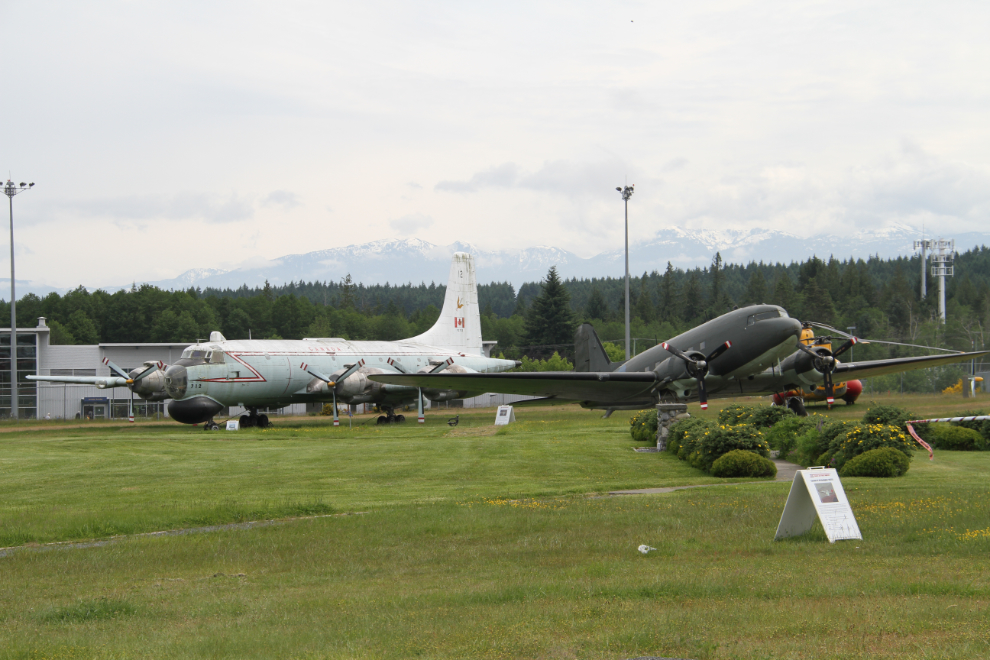
Canadair CF-104 Starfighter #104731. The CF-104 was never based at Comox, but was in service from 1961 until 1988.

Looking back at the Heritage Air Park entrance.

I was starting to think that I’d stay parked there for the night. Being that close to these aircraft, even with a fence between us, felt really good.
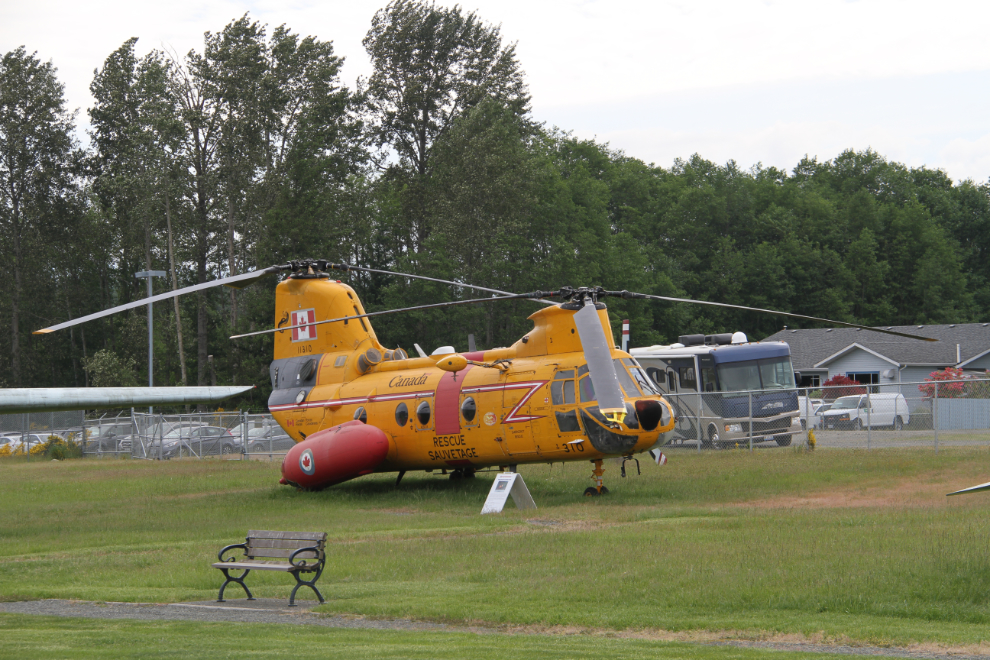
This is the museum’s Heritage Stone memorial area. Each stone, crafted on Vancouver Island from marble mined near Tahsis, is engraved with a person’s name, a coloured Roundel and lightning flash as seen on RCAF and CF aircraft.
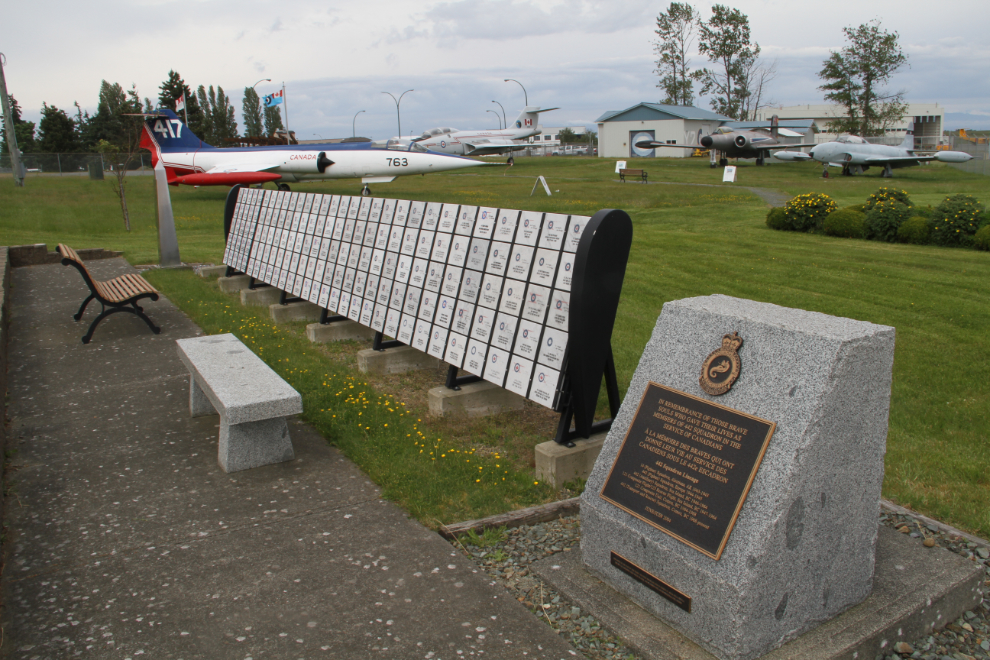
At 4:10, I saw W/O Michael Barnucz waiting to lock the gate so took this final photo and left. We chatted for another few minutes, and he again offered to stay until I was finished, but “finishing” in a yard full of old aircraft would not be quick!
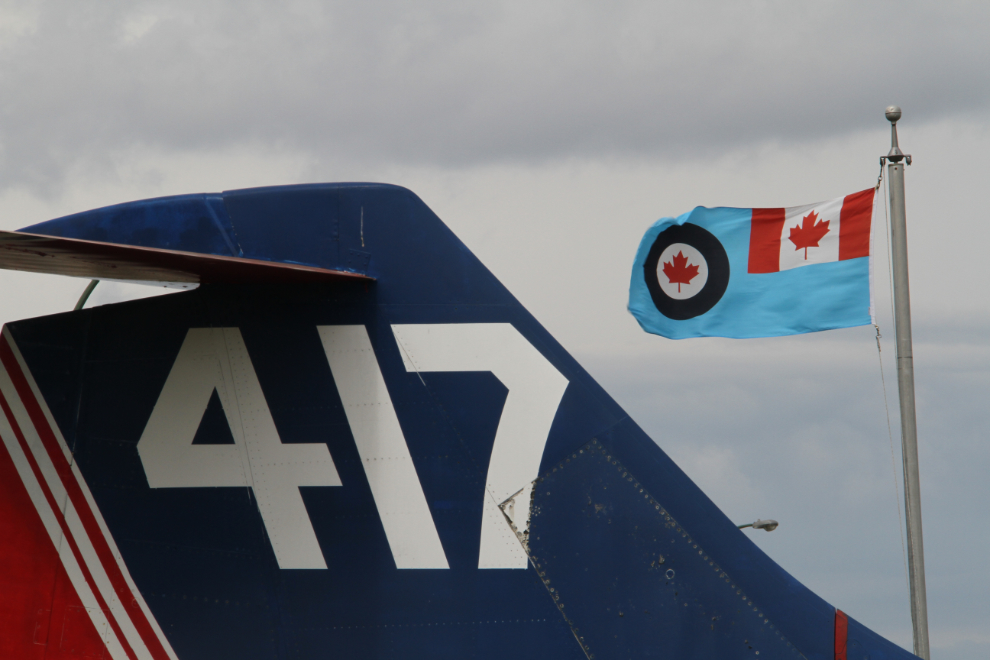
Not sure yet where to spend the night, I drove the Tracker to the ferry terminal to see if that might be a better option. The beach is fairly nice but, no, I didn’t want to park there.
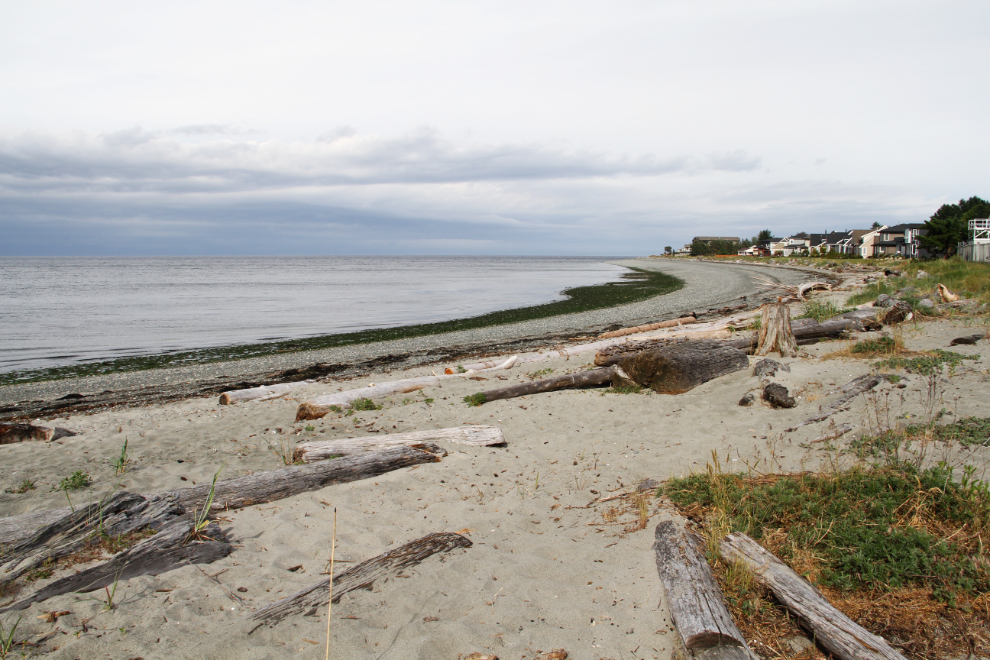
These deer warning signs are seen everywhere in Comox.
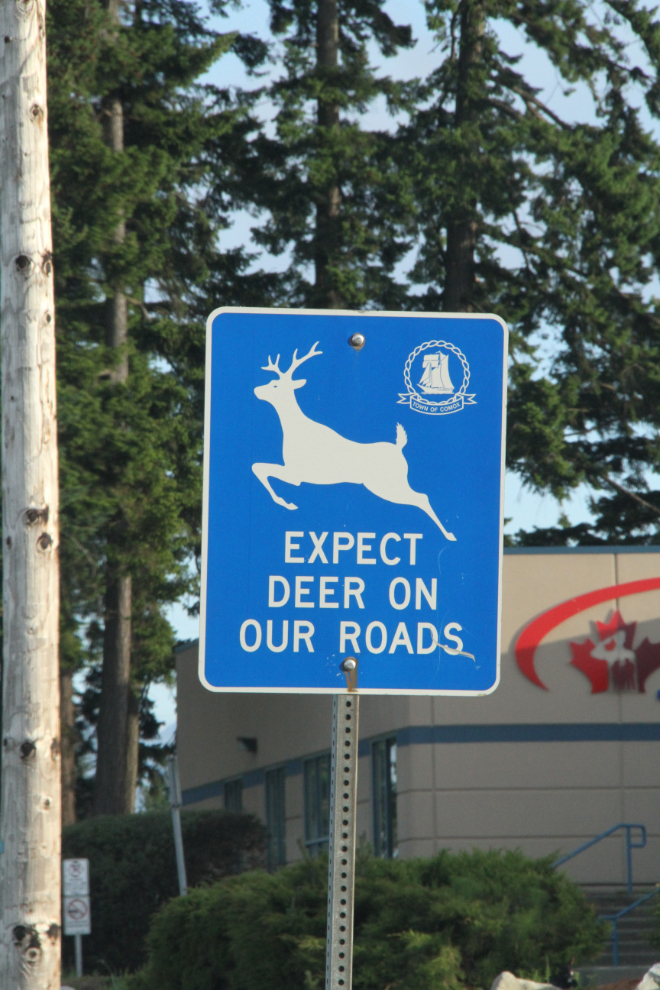
When I got back to the motorhome just before 6:30, the light was wonderful. This helicopter is Boeing-Vertol CH-113A Labrador #11310.
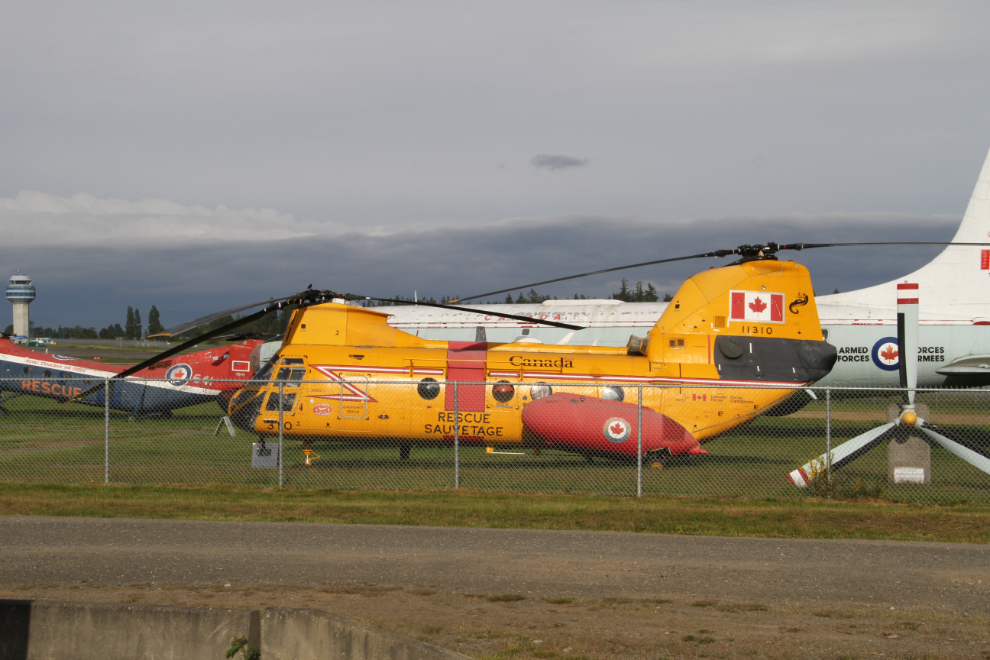
This propeller from an Argus maritime patrol aircraft was installed to commemorate the 50th anniversary of 407 Maritime Patrol Squadron.
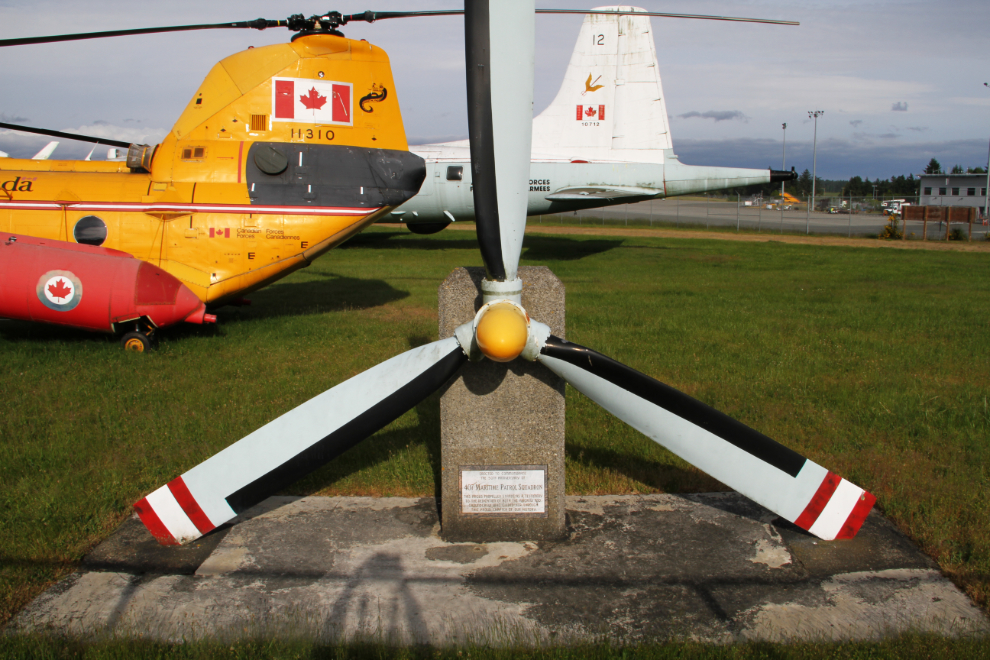
That evening, there was a parade at the 888 Wing Air Cadets next door. I didn’t go over, but all sorts of pomp and ceremony, and music and drums, went on for hours 🙂

As well as the old aircraft, there was plenty of new aircraft action in front of me. At the far side of the parking area was C-GSBJ, the first Embraer EMB-500 Phenom 100 corporate jet I’d seen. This one, from Prince George, BC, was built in 2010.
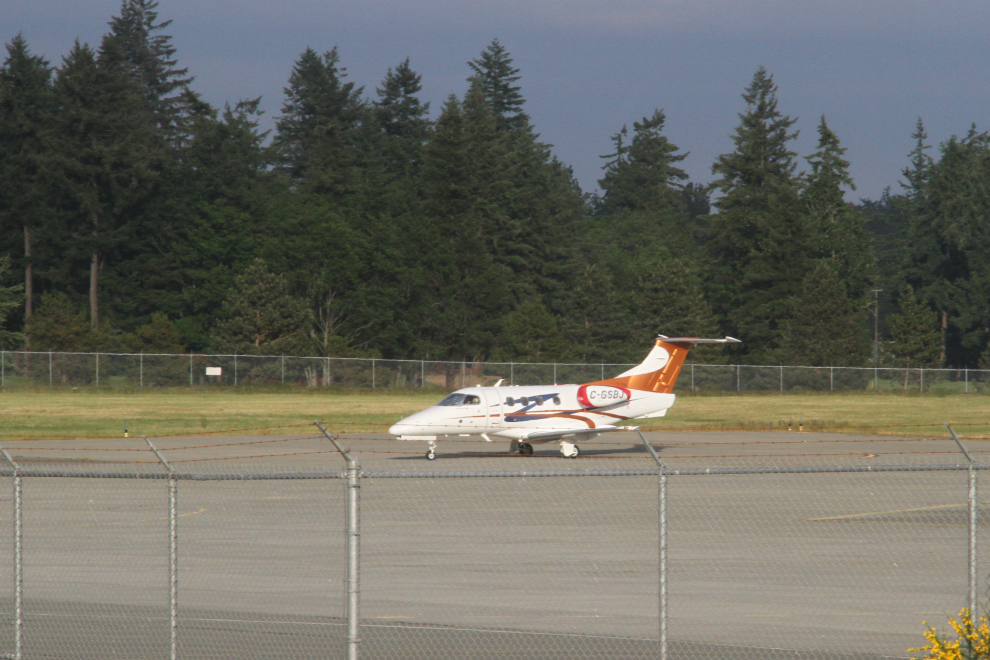
Walking around the fence, I hadn’t even noticed before that the air force museum had a building with vehicles in it.
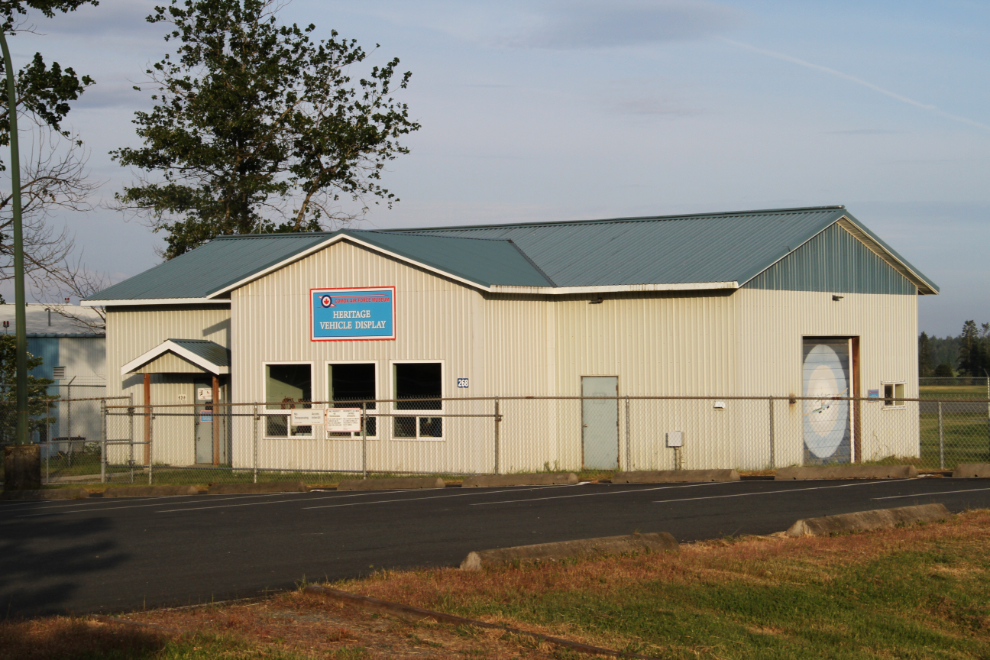
Peeking over the fence at Avro CF-100 Canuck Mark 5 #100790. The Canuck was in service from 1951 until 1984.
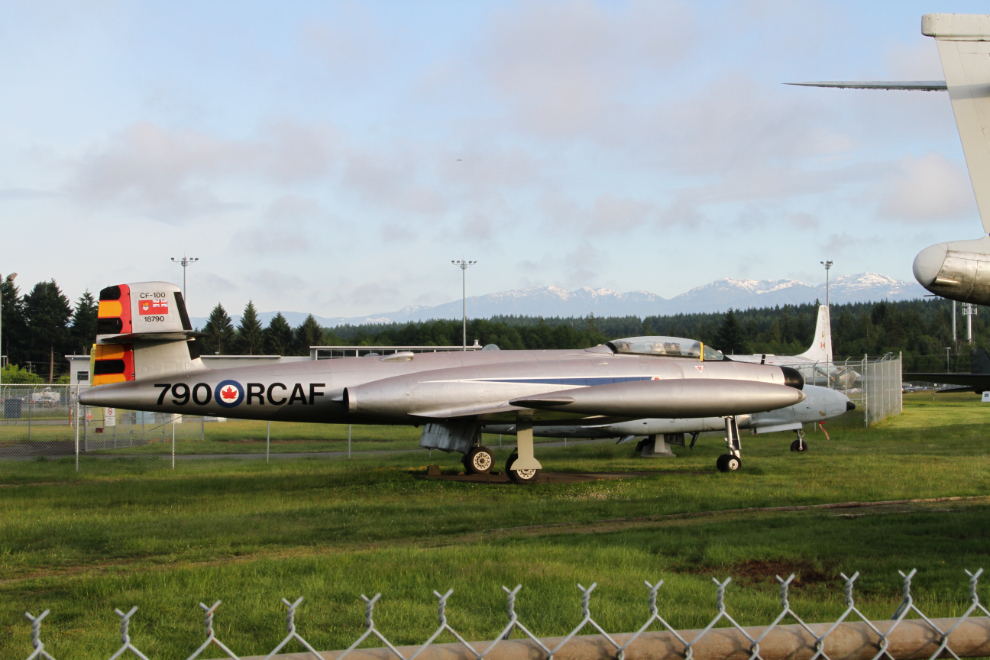
I had a good night’s sleep (nobody came knocking on the door telling me to move 🙂 ), and it was a lovely dawn.
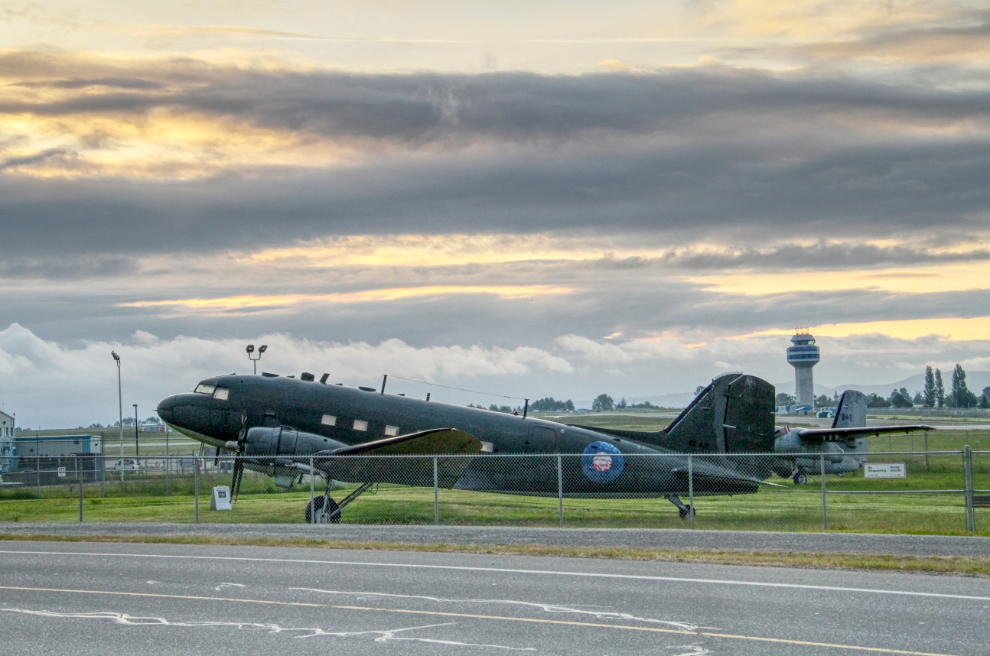
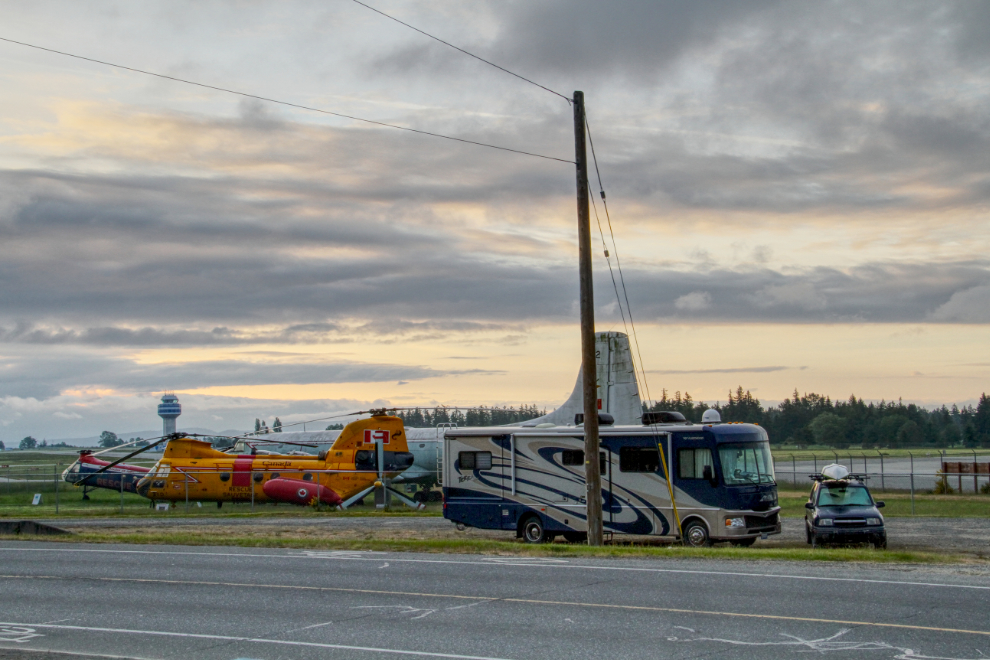
I hooked the Tracker up and left the Comox airport at about 06:30. It’s only 8 km (5 mi) to the ferry, but I appreciated that nobody questioned my overnight parking and didn’t want to overstay my welcome at the airport. The next destination would be Powell River, the start of a week or so on the Sunshine Coast.